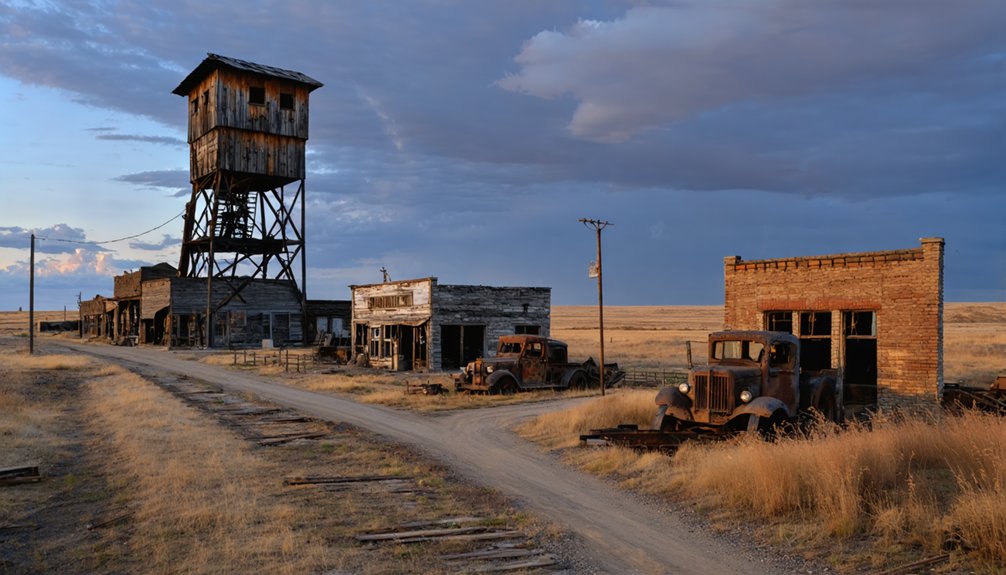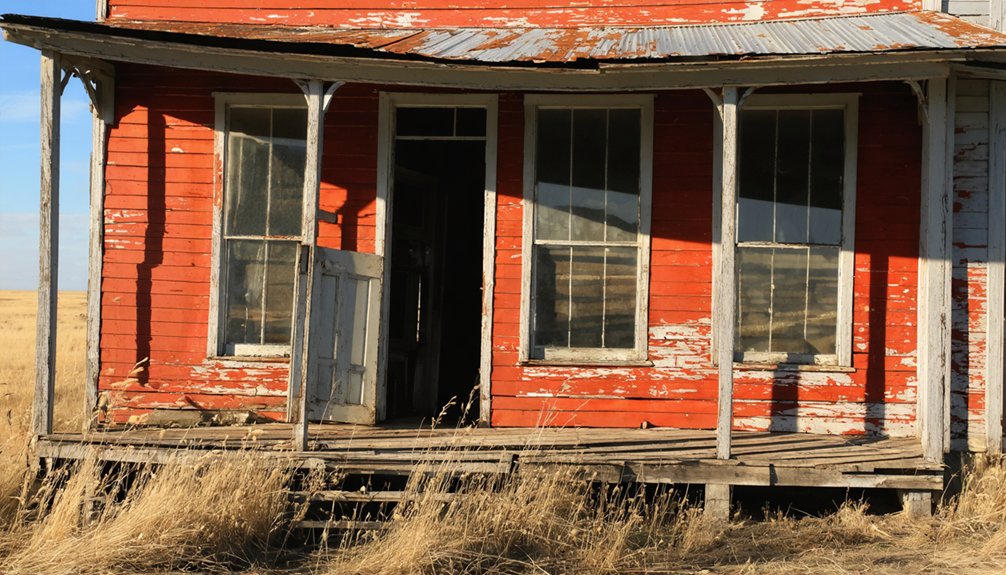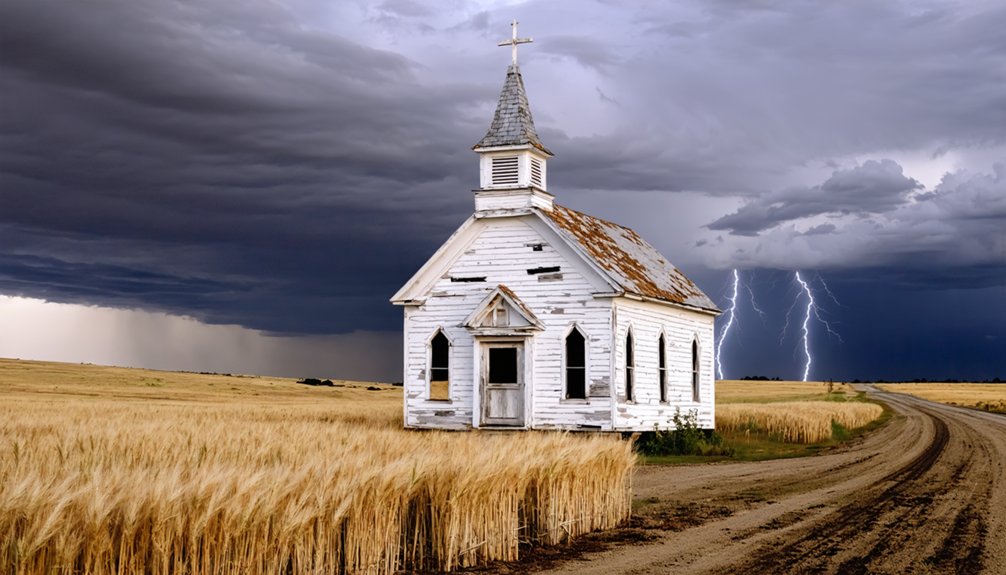You’ll find Pinkerton nestled in South Dakota’s Black Hills, where it emerged during the 1870s gold rush. The ghost town showcases remnants of its mining heyday, including weathered stamp mills, abandoned mine shafts, and rugged architectural features amid dense pine forests. The site’s elevation starts at roughly 5,500 feet, with historic buildings reflecting the boom-and-bust cycle of frontier life. The town’s preserved structures and mining artifacts tell a deeper story of Black Hills settlement and prosperity.
Key Takeaways
- Pinkerton emerged during the Black Hills gold rush of the 1870s, featuring extensive mining operations including the historic Jones and Pinney Mill.
- The ghost town contains architectural remnants of brick stores, mining buildings, and abandoned worker housing amid dense pine forests.
- Mining operations evolved from basic placer extraction to sophisticated crushing and mercury amalgamation processes during its peak economic period.
- Local historical societies actively preserve Pinkerton’s heritage through volunteer clean-ups, guided tours, and interactive mobile experiences for visitors.
- Located in the rugged Black Hills region, Pinkerton sits among steep ridges and rocky outcrops at approximately 5,500 feet elevation.
The Rise and Fall of a Mining Frontier
When gold was discovered in the Black Hills during the mid-1870s, Pinkerton emerged as one of many ambitious mining settlements hoping to strike it rich.
You’d have found early prospectors working placer deposits near French Creek and Deadwood, while Pinkerton’s miners soon followed the rush after the Homestake Mine’s success in Lead.
By 1875, nearly 4,000 settlers had already illegally entered the Black Hills region despite treaty restrictions. The discovery of gold by Custer’s expedition in August 1874 had set the stage for this massive influx of miners.
Life in Early Pinkerton
Beyond the rush for gold, daily life in early Pinkerton centered on building a lasting community from scratch.
The Homestead Act of 1862 brought many settlers seeking land claims in the Dakotas. You’d find settlers purchasing 20-40 acre parcels, constructing practical homes with octagonal designs and sod walls. Dutch and Czech immigrants clustered together, maintaining their cultural ties while adapting to frontier challenges. Rail lines brought essential supplies and livestock, though many settlers still faced long overland journeys to reach their homesteads. The Dakota Boom of the 1870s and 1880s brought significant population growth to settlements like Pinkerton after the railway was completed.
Key aspects of settler experiences included:
- Building homes that doubled as social spaces, with porches serving as centers of family life
- Breaking sod and cultivating at least 10 acres to meet Homestead Act requirements
- Gathering at churches and schools to maintain community bonds despite the isolation
Geographic Features and Natural Setting
You’ll find Pinkerton nestled within the rugged Black Hills region, where steep ridges and rocky outcrops define the challenging terrain typical of southwestern South Dakota.
Like many mining communities that emerged in 1875, the town developed rapidly amid the region’s promising mineral deposits.
The ghost town’s remnants lie amid dense pine forests, with spruce and fir trees creating a woodland setting that’s reclaimed much of the abandoned site.
The area’s continental climate brings cold winters with substantial snowpack and warm summers, which historically influenced the town’s accessibility and daily life.
Today, much like other ghost towns, the site has largely reverted to pasture, with few traces of its original structures remaining.
Terrain and Elevation Characteristics
Due to limited historical records and documentation, specific details about Pinkerton’s terrain and elevation characteristics remain unclear.
While you won’t find exact elevation measurements or detailed terrain analysis for this South Dakota ghost town, understanding the region’s typical landscape patterns could provide context for Pinkerton’s likely geographic setting.
- South Dakota’s varying terrain features often include rolling prairies, rugged badlands, and dramatic elevation changes that would have influenced the town’s development.
- The state’s diverse topography ranges from plains to hills, suggesting Pinkerton’s location could have been shaped by similar natural features.
- Without confirmed historical data about Pinkerton’s specific terrain characteristics, you’ll need to rely on broader regional geography to envision the ghost town’s physical setting.
The elevation in this region typically starts at 5,500 feet, as evidenced by the starting point of Spearfish Canyon Lodge.
A visit to Pinkerton typically requires a short hike to access the site, similar to other ghost towns in the region.
Black Hills Woodland Setting
The Black Hills woodland setting surrounding Pinkerton features three distinct forest zones dominated by ponderosa pine, with significant patches of aspen, bur oak, birch, and Rocky Mountain juniper interspersed throughout.
You’ll find spruce forests thriving in higher elevations and along canyon bottoms, while ponderosa pines prefer the drier, rocky, south-facing slopes. These vital spruce ecosystems contain trees that can reach 300 years old.
As you explore these forest ecosystems, you’ll discover montane meadows and grasslands that make up roughly 10% of the area.
These rare grasslands serve as natural firebreaks and provide critical habitat diversity for wildlife. The landscape’s mosaic pattern includes everything from open savannas to dense forest stands, shaped by historic low-intensity fires.
Native grasses and forbs dominate the meadows, though they’re occasionally threatened by encroaching junipers and small pines. Recent habitat enhancement efforts focus on removing encroaching trees to restore the area’s historic vegetative structure.
Regional Weather Patterns
While the Black Hills forests create their own microclimate, Pinkerton’s broader weather patterns reflect its northern Great Plains location, with dramatic temperature swings throughout the year.
You’ll experience extreme climate variability, from frigid winters dipping below 0°F to warm summers reaching into the mid-80s. The open prairie landscape intensifies weather extremes, with powerful winds sweeping across the unobstructed terrain.
- Winter brings blizzards and drifting snow, with 7-8 inches of accumulation in peak months.
- Spring and summer storms can release severe thunderstorms, hail, and occasional tornadoes.
- Fall shifts quickly into winter, as the jet stream moves southward and Arctic air masses descend.
Annual precipitation averages 24 inches, with May through August being the wettest period.
Long-term trends show warming temperatures and increasing heavy rainfall events.
Mining Operations and Economic Legacy

You’ll find evidence of Pinkerton’s mining heyday in the remnants of its hard rock mining infrastructure, which evolved from early placer operations to more sophisticated processing methods by the 1880s.
The area’s economic prosperity peaked during its active mining years, with stamp mills and cyanide treatment facilities processing gold from both surface and underground operations.
The development of advanced milling technology, including the historic Jones and Pinney Mill, transformed Pinkerton into a significant gold processing center in the Black Hills region.
Gold Mining Infrastructure
Deep beneath South Dakota’s rugged terrain, hard-rock mining operations transformed Pinkerton’s landscape as prospectors pursued gold-rich quartz veins similar to those found near Lead and Deadwood.
Mining techniques evolved from basic placer extraction to sophisticated crushing and mercury amalgamation processes, requiring substantial infrastructure development to support these operations.
You’ll find evidence of the region’s mining heritage through:
- Processing facilities that used chlorination and smelting to extract gold from refractory ores
- Support buildings including boarding houses, offices, and specialized processing plants
- Smelting complexes designed to handle difficult ores from nearby Ruby Basin and Bald Mountain
The mining infrastructure you see today reflects the innovation and determination of early prospectors who adapted their methods to tackle increasingly complex ore extraction challenges in their pursuit of independence and prosperity.
Peak Economic Prosperity
The Black Hills gold rush reached its zenith in the late 1870s, transforming the region’s economic landscape far beyond the mining infrastructure.
You’d have seen thousands of settlers flocking to boomtowns, with Deadwood and Lead emerging as economic hubs. While most small claims yielded modest returns of $30,000-$80,000, the economic boom spurred widespread community development through support industries and railroads.
The Homestake Mine, established in 1876, became the region’s cornerstone employer, offering steady wages and employee stock ownership.
You’ll find it’s the only operation that truly prospered long-term, while smaller mines struggled with rising costs and low-grade ore. By the early 1900s, most small operators had shut down, though Homestake’s success continued sustaining the local economy until its closure in 2002.
Architectural Remnants and Historical Sites
Standing among the windswept prairies of South Dakota, Pinkerton’s architectural remnants tell a compelling story of its railroad and mining heritage.
You’ll discover deteriorating wooden grain elevators and two-story brick stores that showcase the town’s architectural styles. Community structures, from warped wooden churches to small jails with rusty window bars, stand as silent witnesses to a bygone era.
Crumbling elevators and weathered storefronts paint a portrait of Prairie life, while aging churches and jail cells whisper stories untold.
Here’s what you’ll find as you explore:
- Railroad infrastructure, including overgrown tracks and abandoned worker housing from the Chicago, Burlington & Quincy Railroad’s 1889 arrival
- Mining-related buildings with scattered frameworks and connected housing near former mining camps
- Historical landmarks like early 1900s schools and post offices, now weathered but preserving the town’s authentic character
Ghost Town Tourism and Preservation Efforts

While ghost towns across South Dakota face preservation challenges, Pinkerton’s tourism initiatives have evolved to protect its historical legacy.
You’ll find local historical societies leading preservation efforts through volunteer clean-ups, site maintenance, and protective measures against vandalism. Interactive mobile apps and guided tours now enhance your experience by bringing the town’s past to life.
As part of the region’s growing ghost town tourism circuit, Pinkerton attracts history enthusiasts and photographers seeking authentic frontier experiences.
You can support preservation efforts through entrance fees and merchandise purchases, which fund ongoing conservation work. The site’s sustainability measures balance visitor access with heritage protection, ensuring you’ll discover a well-maintained glimpse into South Dakota’s pioneering past while helping preserve it for future generations.
Frequently Asked Questions
Were There Any Notable Crimes or Lawlessness Reported in Pinkerton’s History?
Like a blank sheriff’s badge, you’ll find no documented crime history in the historical records. While regional lawlessness was common in Black Hills towns, no specific incidents or law enforcement issues were reported here.
What Happened to the Original Mining Equipment and Machinery After Abandonment?
You’ll find most equipment rusted away on-site due to costly relocation efforts, though some parts were salvaged or scrapped. Today, mining heritage preservation efforts protect remaining machinery as historical artifacts.
Did Any Famous Historical Figures Ever Visit or Stay in Pinkerton?
You won’t find evidence of famous visitors in available records. While notable figures like Calamity Jane frequented nearby towns, Pinkerton’s historical significance doesn’t include documented stays by Western legends.
Were There Any Native American Settlements Near Pinkerton Before Mining Began?
Like winds across the prairie, you’ll find that while no permanent settlements existed exactly there, Native American groups – primarily Sioux – used the area seasonally for hunting and camping before mining began.
What Happened to the Cemetery and Burial Records From Pinkerton?
You’ll find most burial documentation was lost over time, with only six memorial records surviving on Find a Grave. The abandoned cemetery’s preservation ceased, leaving minimal traces of those interred there.
References
- https://www.historynet.com/ghost-town-tinton-south-dakota/
- https://www.powderhouselodge.com/black-hills-attractions/fun-attractions/ghost-towns-of-western-south-dakota/
- https://en.wikipedia.org/wiki/Tinton
- https://www.youtube.com/watch?v=Glucs_Rq8Xs
- https://www.sdpb.org/rural-life-and-history/2023-08-21/some-black-hills-ghost-towns-and-their-origins
- https://www.sdhspress.com/journal/south-dakota-history-2-2/some-black-hills-ghost-towns-and-their-origins/vol-02-no-2-some-black-hills-ghost-towns-and-their-origins.pdf
- https://www.youtube.com/watch?v=_0WNYsFLSLA
- https://en.wikipedia.org/wiki/List_of_ghost_towns_in_South_Dakota
- https://icatchshadows.com/okaton-and-cottonwood-a-photographic-visit-to-two-south-dakota-ghost-towns/
- https://blackhillsminingmuseum.com/learn/history



